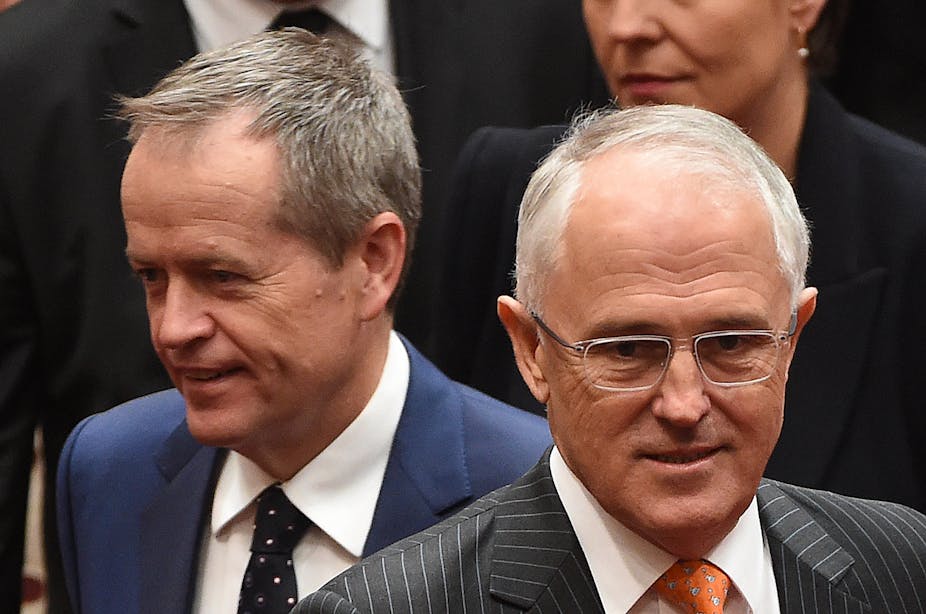Federal elections are fecund sources of lessons for the political class.
From 1993 they learned not to make a big target of yourself as an opposition party. The Coalition’s Fightback! gave Paul Keating hundreds of pages to work with. It helped produce an iconic moment when Liberal leader John Hewson was unable to explain to television interviewer Mike Willesee how the proposed Goods and Services Tax would affect the price of a birthday cake. Hewson never recovered.
Far better, political operatives concluded, to slip into office quietly, promising little (except the hardy perennial of tax cuts). John Howard won office with a small-target strategy in 1996, vowing to make Australians “comfortable and relaxed”.
In 2007 Kevin Rudd presented himself as Howard-lite, a fiscal conservative who advised Labor supporters on election night to go home and have a strong cup of tea and some Iced VoVos.
Tony Abbott also made a small target of the Coalition in 2013. This had disastrous consequences when voters came to realise, in the wake of the 2014 budget, that he intended changes wildly out of line with the impression created earlier.
Our politics have for the last generation been haunted – some might say impoverished – by the “small-target” lesson of 1993. It has arguably acted as a disincentive to hard policy work in opposition, to the bold articulation of big ideas by political parties, and to frankness in campaigns. Detail is the enemy.
Labor under Bill Shorten has given the impression that it would like to do things a little differently, by revealing some policy detail well in advance of the campaign.
Malcolm Turnbull, too, has tried to promote policy debate since taking the leadership in September, but has grown more cautious in the face of attacks by Labor and the right wing of his own party, as well as disappointing polling.
The weeks ahead will show to what extent the lessons of 1993 have been learned. But there are clearly some on the Labor side who seem willing to flirt with the idea that if you make yourself too small a target, you will lack a mandate to do anything once in office. This is the hard lesson of Abbott’s prime ministership.
Other election campaigns have also acted as tutorials in how to do, or not to do, federal politics in Australia. The 1984 campaign seems to have particular relevance at present. It was a very long campaign – about as long as the one on which we have just embarked. An early election called by Prime Minister Bob Hawke, it was intended to take advantage of his stellar personal popularity and economic recovery.
Most commentators expected a crushing Labor victory. But the swing from the government was almost 2%. Its majority shrank from 25 to 16 seats in a House of Representatives that had been enlarged from 125 to 148.
A post-election internal Labor review identified the unusual length of the campaign as one of the reasons for this disappointing result. The enduring lesson learned from 1984 was: don’t do long election campaigns.
Whether this is bad news for Turnbull is not entirely clear. It is true that the polls suggest he is in a notably weaker position than Hawke was in 1984; that surely points to vulnerability.
But Labor’s 1984 postmortem speculated that Hawke’s extraordinary ascendancy might actually have worked against the government: that expectations of a landslide led some to clip Hawke’s wings, to discourage a Labor government from getting too far ahead of itself.
There were, in any case, other reasons why Labor did poorly in 1984. Hawke was off his game – one of his daughters had a drug addiction and he was suffering a painful eye injury due to a cricketing accident. And Labor’s campaign, even by its own account, lacked vision, purpose and direction, with opposition leader Andrew Peacock able to set the agenda.
No doubt Shorten would like this comparison, with its hint of opportunity for a smart and dogged alternative leader.
Some commentators have seen parallels between this year and the 2004 election, when Labor’s Mark Latham won a series of tactical victories before the election only to lose the election itself. But the comparison seems forced. Latham began to falter well before the campaign (notably over Labor’s policy in Iraq) while actually performing creditably during most of the campaign itself.
The wheels fell off in an obvious way only at the end, especially over forestry policy in Tasmania and in another of those iconic election moments: an aggressive handshake with Howard on the campaign trail.
While it is easy enough to predict what kinds of scare campaigns will be launched against Shorten – over union power, carbon taxes and negative gearing – it cannot be taken for granted that these will have an effect comparable to Howard’s over interest rates against Latham.
The truth is that while the lessons taken out of particular campaigns can have enduring effects, each presents a unique pattern of opportunities and dangers for the participants. Right now, in the aftermath of a budget, Turnbull will be hoping for a scenario like in 1987, when Labor ran a successful campaign in the last double-dissolution election on the back of Keating’s well-received May economic statement.
However, Turnbull will not get the kind of assistance that Hawke’s 1987 effort received from Joh Bjelke-Petersen’s crazed effort to become prime minister – unless, of course, there’s an unstable Labor premier lurking out there with cunningly disguised federal ambitions.

